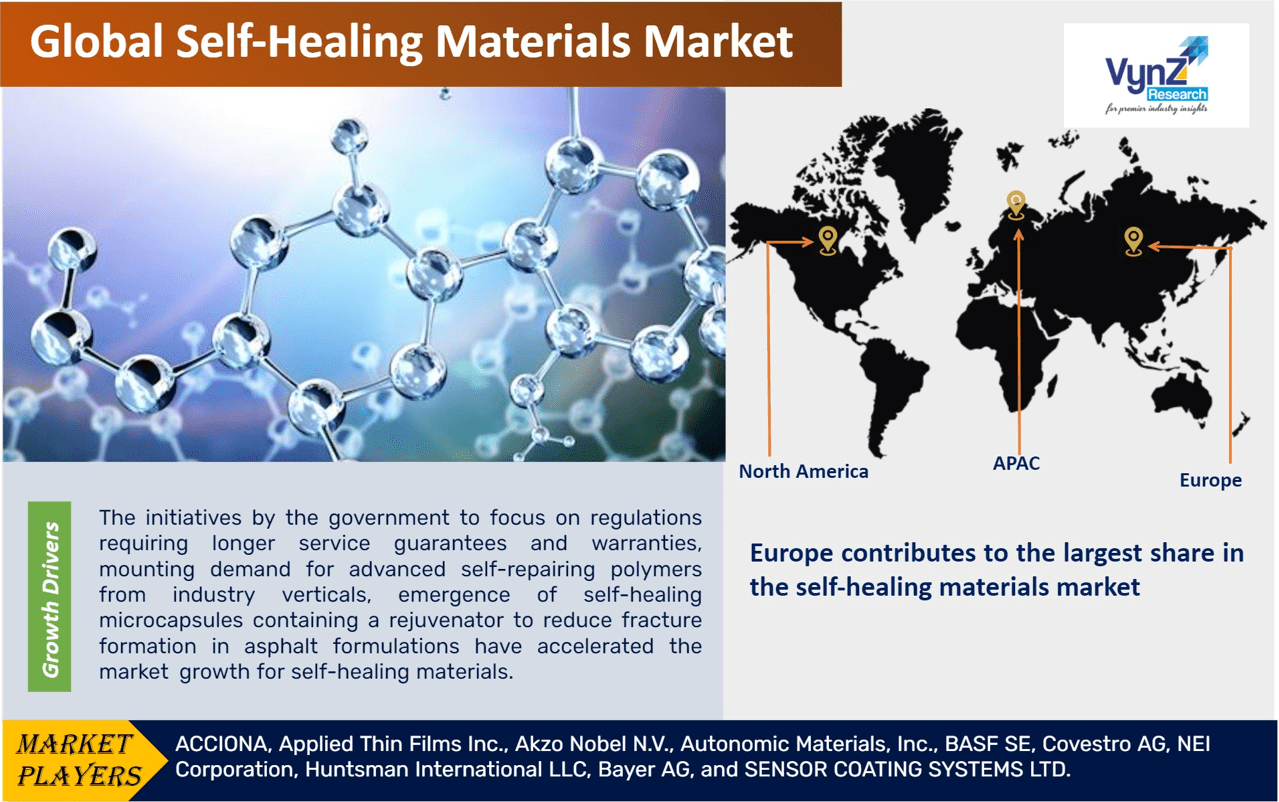Industry Overview
During the forecast period 2025-2030, the global self-healing materials market is expected to increase at a CAGR of 62.6 percent, from USD 2.1 billion in 2023 to USD 61.55 billion in 2030. Self-healing materials are artificial or synthetically made materials or goods that have the potential to heal damage automatically and autonomously without the need for external or human intervention. Concrete and coatings applications frequently use self-healing materials.

Due to expanded application areas, technological developments, and rising demand in Europe, its market is booming. The burgeoning building and construction sector, as well as increasingly demanding structural integrity rules, are driving demand for self-healing materials. Nevertheless, self-healing materials are predicted to be cheaper in use owing to their high reliability, reduced maintenance, cost, and long lifetime.
Self-Healing Materials Market Segmentation
Insight by Form
Based on form, the global self-healing material market is divided into extrinsic and intrinsic. The extrinsic are sub-divided into capsule-based and vascular. The extrinsic self-healing materials category accounts for the majority of the market for self-healing materials. The unique combination of properties makes it helpful in a wide range of industries, which is the primary driver of the market for self-healing materials. It enables the restoration of material functionalities such as material damage/cracking and others in a simple and fluid manner.
Insight by Material Type
Concrete, coatings, polymers, asphalt, fiber-reinforced composite, ceramics, and metals are the material types that make up the global self-healing material market. The polymer segment dominates the self-healing material market owing to its property to heal on its own without any intervention when it suffers damage.
The concrete segment is expected to rise at a high CAGR during the forecast period, owing to the product's strength and durability, as well as its widespread use in essential applications in the building and construction industry, which is driving up demand for self-healing concrete in the market. Moreover, the increasing demand from the building & construction industry in Europe & Asia-Pacific will propel the demand for the concrete segment in the self-healing materials market.
Insight by Technology
Based on technology, the global self-healing materials market is segmented into reversible polymers & elastomers, microencapsulation, shape-memory materials, biological material systems, and others. The reversible polymers hold the largest share in the market owing to the enhanced rebinding properties of reversible polymers and elastomers. The rise in demand for reversible polymers and elastomers technology is being fueled by an increase in demand from the medical/healthcare sector due to an expansion in the scope of applications. The biological material systems are anticipated to witness a high CAGR during the forecast period owing to the rising geriatric population demanding biological self-healing material, resulting in the growth of the market.
Insight by Application
Based on application, the global self-healing materials market is divided into energy generation, building & construction, automotive & transportation, electronics & semiconductors, medical, and others. The building & construction segment dominates the self-healing material market during the forecast period owing to its increased adoption of such materials in non-residential construction as it has the ability to repair early-stage damage, which if unimpeded, will lead to material failure. The increased adoption of self-healing materials in the automotive industry will accelerate growth at a faster pace during the forecast period. Anti-scratch polyurethane coatings based on self-healing elastomers for automobile bodies are among the uses in the automotive sector.
Industry Dynamics
Industry Trends
The rising global population will lead to an increased demand for housing and various other infrastructures, resulting in increased investment in commercial and real estate. Investment in research and development is being used to develop and launch products that are in the lower and cheaper price range, resulting in providing a new era of infrastructure preservation and environmental management technologies are the key trends in the self-healing materials market.
Self-Healing Materials Market Growth Drivers
The initiatives by the government to focus on regulations requiring longer service guarantees and warranties, mounting demand for advanced self-repairing polymers from industry verticals, emergence of self-healing microcapsules containing a rejuvenator to reduce fracture formation in asphalt formulations have accelerated the market growth for self-healing materials. Furthermore, knowledge transfer and close collaboration during the early-stage development, robust industrialization, increasing investment, rising demand for energy-efficient construction solutions,
Self-healing materials are anticipated to be less expensive in due time than conventional counterparts owing to their enhanced reliability, increased efficiency, lower maintenance costs, the ability of materials to repair damages caused due to mechanical friction, and longer lifetime.
Self-Healing Materials Market Challenges
The increased cost of material as compared to traditional material, the presence of substitutes, limited awareness of products in emerging economies, and issues related to scaling up from pilot scale to industry scale production will pose challenges to the self-healing material market. During the forecast period of 2025-2030, the self-healing materials market is expected to face challenges in terms of profitability and competition too.
Self-Healing Materials Market Opportunities
Self-healing materials greatly reduce maintenance tasks, lowering MRO costs. This will, in turn, provide opportunities for the key market players. The increasing capital expenditure by companies in the industry is anticipated to open new avenues for growth of the self-healing materials market.
Recent Developments By the Key Players
BASF has launced Prexio Active which is a new insecticide active ingredient.
Huntsman Corporation has opened a new innovation center in Tienen, Belgium recently, that is strengthening its research and development (R&D) capabilities and reinforcing its commitment to its customers in the region.
Self-Healing Materials Market Geographic Overview
Europe contributes to the largest share in the self-healing materials market owing to the increased adoption of self-repairing specialty polymers, investment in infrastructure development, increased R&D activities, expansion of automobile production, and process innovation. Moreover, developing the healthcare infrastructure industry with huge investments in biometric and the presence of major OEMs in the region will drive the growth of the self-healing materials market.
Asia-Pacific is anticipated to have high growth during the forecast period owing to the expansion of the construction industry, robust industrialization, rising population, mounting investment by the government in the retail sector, and increased per capita income in the region.
Self-Healing Materials Market Competitive Insight
The industry players are entering into M&A, joint ventures, partnerships, innovation, product launch and development, and product expansion to offer next-generation solutions to the customers and accelerate the growth of the self-healing materials market. Because of the increased competition among market competitors, companies have begun to focus on developing multifunctional coatings.
Some of the key players in the self-healing materials market include ACCIONA, Applied Thin Films Inc., Akzo Nobel N.V., Autonomic Materials, Inc., BASF SE, Covestro AG, NEI Corporation, Huntsman International LLC, Bayer AG, and SENSOR COATING SYSTEMS LTD.
.png)
Region Covered in the Report
• North America
- U.S.
- Canada
- Mexico
• Europe
- Germany
- U.K.
- France
- Italy
- Spain
- Russia
- Rest of Europe
• Asia-Pacific (APAC)
- China
- Japan
- India
- South Korea
- Rest of Asia-Pacific
• Rest of the World (RoW)
- Brazil
- Saudi Arabia
- South Africa
- U.A.E.
- Other Countries




.png)